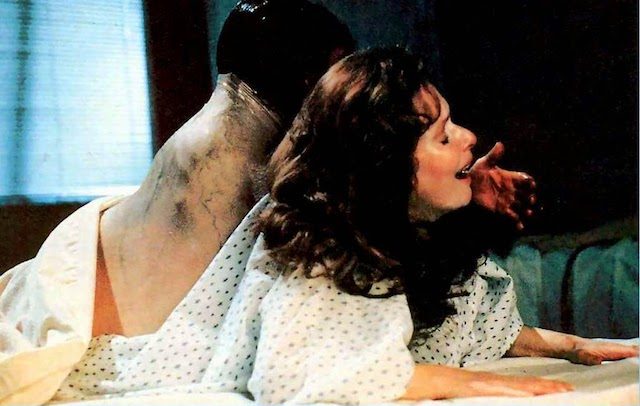
Another week, another cookie-cutter piece of junk from the Hollywood assembly line. Can’t they ever come up with anything new? No, of course not. Instead, we get “The Manitou,” about a woman who has a tumor on her neck that turns out to be a fetus, and the fetus turns out to be the reincarnation of an evil Indian shaman, and the evil Indian shaman pops out of the lady’s neck and tries to kill everyone. YES, THAT OLD PLOT AGAIN.
Mystical Native American stuff was big in the 1970s, when “The Manitou” came out. Also very big, apparently, was having your 53-year-old male lead wear tight jeans and other age-inappropriate clothing, as Tony Curtis does throughout “The Manitou.” The ’70s were a weird time all around. Let’s just move on.

Curtis plays Harry Erskine, a fraudulent San Francisco psychic who takes old ladies’ money in exchange for pretending to derive meaning from randomly shuffled tarot cards (which is actually a fairly legitimate job for San Francisco). Harry Erskine is the main character of this movie, but he is not the one with an Indian growing in his neck. That would be silly. The one with the neck-Indian is Karen Tandy (Susan Strasberg), Harry Erskine’s ex-girlfriend. We aren’t told why they broke up, but we are told that Karen is 29 years old, so I think I’ve found the answer. Unless Harry Erskine is supposed to be much younger than Tony Curtis is, in which case ha ha ha.
Anyway, Karen has just been informed by the doctor that the tennis-ball-sized tumor on the back of her neck is slightly larger than you want tumors in that part of the body to be, so they’re going to do a biopsy and see, in medical terminology, what the eff the deal is. Susan, who is worried and apparently has no friends, calls her ex-boyfriend, Harry Erskine, whose name sounds like “Hairier Skin” every time it is uttered, which is frequently. Mr. Skin assures her everything will be fine; duly comforted, Karen has sex with him.
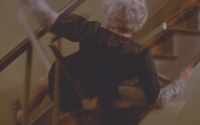
Afterward, Karen starts chanting some gibberish in her sleep, something like “PANNA WITCHY SALAD TOO.” Harry finds this peculiar — and Harry is a fake fortune-teller who just hooked up with a much-younger ex-girlfriend on her way home from having a giant tumor on her neck examined, so his threshold for “peculiar” is pretty high. Even more peculiar: The next day, Harry is pretending to read an old lady’s fortune when suddenly she goes into a trance, shouts “PANNA WITCHY SALAD TOO!,” levitates down the hall, and throws herself down a flight of stairs, smashing through the banister as if it were made of cardboard (spoiler: it was). While this is happening, a surgeon at the hospital is trying to remove Karen’s tumor, but the tumor gets angry (?) and makes the surgeon slice his own arm with the scalpel. Karen has no idea what’s happening to her and goes catatonic for a while, when she’s not busy screaming.
Harry consults with Karen’s physician, Dr. Hughes (Jon Cedar), who was made out of leftover Steve McQueen and Ted Koppel parts. Dr. Hughes has no problem discussing Karen’s medical condition with her con-artist ex-boyfriend, and he reports that there’s something weird about this tumor. “You could almost describe it as a fetus,” he says.

Here is where any sane person thinking of producing this film would stop reading the screenplay and say, “Oh, never mind.” Once you’ve announced that your central female character’s neck is pregnant, it’s unlikely the audience will take anything else you say seriously. Too many questions arise. Would removing the tumor now technically be an abortion? If she carries it to term, will the baby be delivered through her mouth? How do you get neck-pregnant, anyway? When we were teenagers, and church youth-group leaders were warning us against the dangers of “necking,” is this what they were talking about? “You have a kink in your neck? Oh, that’s too bad. I have a BABY in mine.” Will there be a Judd Apatow comedy called “Knecked Up”?

But despite the obvious story problems, “The Manitou” boldly presses forward, secure in the knowledge that before it is over, a pregnant neck will not have been the weirdest thing about it.
Harry Erskine concludes that since Karen is neckxpecting and chanting gibberish in her sleep, someone must be controlling her mind. You might think his logic is missing a step, but I ask you: Have you ever heard of an instance of mind-control in which the victim did NOT also have a tumor-embryo growing in his or her body? I rest my case.

In order to contact whoever is controlling Karen’s mind, Harry Erskine rounds up some mediums and holds a seance, during which the head of an Indian man rises out of the table and moans, as would you if your head were rising out of a table. After that, it just takes a brief visit with a doddering anthropologist played by Burgess Meredith for Harry to figure the whole thing out: The head in the table was Misquamacus, a Native American shaman who died 500 years ago and is now trying to reincarnate himself by gestating in Karen’s neck-womb. Questions such as “Why?” and “Why Karen?” and “Why her neck?” and “What the hell?” are not addressed.
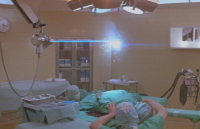
Meanwhile, back at the hospital, the neck-fetus is growing — it’s now more of an upper-back-fetus — and the doctors can’t remove it without killing Karen, an option they dismiss without even considering it. Their last hope is to use lasers to disintegrate the tumor-baby. Alas, the malevolent lump once again takes control, making the lasers shoot at the walls of the operating room, like in “Star Wars.” I’ve never seen surgical lasers up close. I’m fairly confident the filmmakers haven’t either.
All the x-rays and attempted surgeries have only succeeded in upsetting the Indian tumor-fetus. “We’ve created a monster,” Dr. Hughes says, though he didn’t create it, he just angered it, and a man of science should be more precise. Harry figures the best way to fight a medicine man is with another medicine man, so he heads to an Indian reservation in search of one John Singing Rock. When Harry finds him, he’s John Doing Some Yard Work, and he reluctantly agrees to use his shaman skills in fighting Misquamacus.
And not a moment too soon! When they get back to the hospital, Karen looks like Quasimodo, if Quasimodo’s hump had contained a reincarnated Native American mystic trying to claw his way out. Then, without so much as an epidural, out pops a dwarfish, evil-faced little Indian who we assume is Misquamacus. (I mean, who else would it be?) Mazel tov! Pass around the “It’s a shaman!” cigars.
Oh, and in case you were concerned, Karen somehow survived the process of a hundred-pound thing ripping itself out of her back. This is bad news for Misquamacus, because you just know Karen’s going to use the story to give him guilt trips forever.
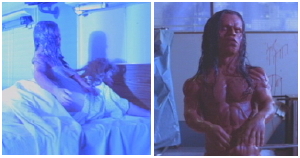
Like all newborns, Misquamacus is tired and cranky and seeks the destruction of all that is good. John Singing Rock has taken the precaution of sprinkling magic sand in a circle around the hospital bed, and this will hold Misquamacus back, but not for long. John Singing Rock then becomes John Explaining Things and explains that everything on Earth has a “manitou,” or spirit, and that Misquamacus works his evil by controlling the manitous around him. John says that even manmade objects have manitous, and his plan is to get the hospital’s computers and machines to combine their manitous and destroy Misquamacus. He achieves this, more or less, and they all live happily ever after (except Misquamacus). The message: ancient Native American spirituality is powerful, but it’s no match for late-’70s computers.
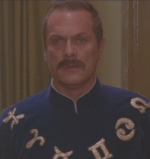
The movie ends with a title card that reads:
“Fact: Tokyo, Japan 1969. A fifteen-year-old boy developed what doctors thought was a tumor in his chest. The larger it grew, the more uncharacteristic it appeared. Eventually, it proved to be a human fetus.”
So … I guess … now the movie was scary? In hindsight? Because a Japanese kid once had a fetus in his chest? Whatever you say, movie. Just keep your Harry Erskine away from me.
— Film.com





